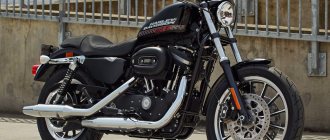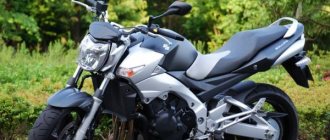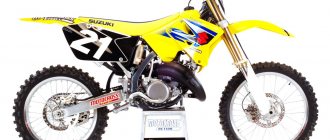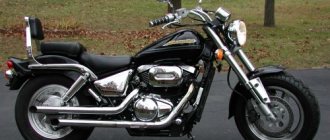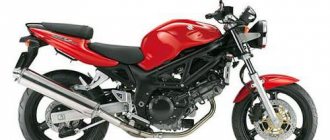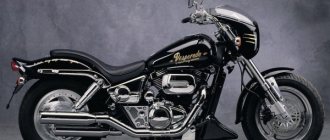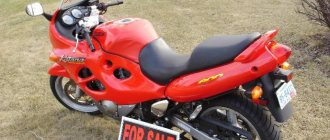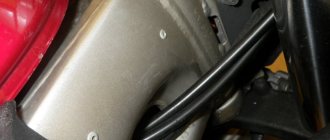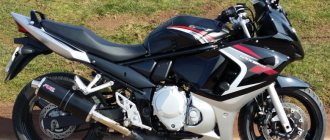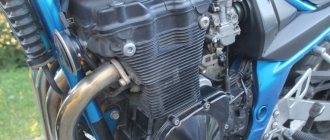Specifications
| Suzuki B-King | naked |
| Year of issue | 2007-2012 |
| Frame | aluminum, 2-section |
| engine's type | 4-cylinder, 4-stroke, in-line, 1340 cc. cm. |
| Compression ratio | 12,5:1 |
| Cooling | liquid |
| Ignition type | transistor |
| Number of valves per cylinder | DOHC, 4 valves per cylinder |
| Fuel supply system | injection (with SDTV and S-DMS system) |
| Maximum power | 183.5 hp at 9500 rpm |
| Maximum torque | 146.4 Nm at 7200 rpm |
| type of drive | chain |
| Transmission | 6 manual transmission |
| Front tire size | 120/70-ZR17M/C (58W) |
| Rear tire size | 200/50-ZR17M/C (75W) |
| Wheelbase | 1,525 mm |
| Seat height | 805 mm |
| Maximum speed | 254 km/h |
| Acceleration to 100 km/h | 2.86 sec |
| Comfortable cruiser | 90-110 km/h |
| Gas tank capacity | 16.5 l (~150 kg way) |
| Motorcycle weight | 235 kg (dry) 262 kg (curb) |
Since the model was planned as a successor to the Hayabusa, they did not change the engine - it was strangled a little . As a result, we achieved good traction throughout the entire rev range. By tradition, SDTV , as well as S-DMS, .
Engine – right side view.
Engine – left view.
The first controls the double fuel flaps, the second controls the engine thrust.
S-DMS can operate in 2 modes:
- full power ( 183 horses );
- trimmed by 60 mares ( 125 horses ).
According to engineers, the second is insurance in case of rain or bad roads.
Transmission and clutch
As on the prototype, the engine was equipped with a 6-speed gearbox .
There are no complaints from users about it - the numbers are convenient, gears are switched on without question, neutral is found right away.
The main drive is standard - chain .
Brakes
Front brakes.
Rear brakes.
According to user reviews, the brakes are simply gorgeous . When designing their brand, they did not rely solely on their own strength. The diameter of the brake rotors is 310/260 mm (front/rear, respectively), there are 2 discs and one .
Brake calipers are Nissin, 4-piston radial caliper front, 1-piston rear.
ABS is installed at the factory, but if you really want, you can find a motorcycle without it.
Honda CB1300DC X4 (1997–2003, RUR 170,000–350,000)
“Khach” is a timeless device. The near-cruiser base thrown over the structure of the CB 1300 turned out to be so successful that the motorcycle instantly fell into the category of timeless legends. The number of fans of the model and fan clubs is so large that in the near future there will no longer be enough motorcycles for everyone.
Engine
The large in-line four with a displacement of 1284 cm3 from the Honda CB 1300 is distinguished by a rather calm temperament and fantastic reliability. Such engines usually die either from poor maintenance or from high mileage. There are cases when X 4 engines were nursed for 300,000–400,000 km without any problems or major repairs.
One of the well-known disadvantages of the X is its gluttony, coupled with its rather small fuel tank (only 15 liters). There is only one known solution to the problem - increasing the tank by welding a spacer into the middle part. But here it is important not to forget about repeated anti-corrosion treatment of the insides. Otherwise, you will suffer with a constantly clogged inlet.
Another serious problem is the relay-regulator that burns out with enviable frequency. The best way out of the situation everywhere and always is, like an avid motorist from the times of the USSR, to carry a replacement part with you.
Transmission
The five-speed gearbox operates Honda-style clearly and smoothly. At high speeds the sixth stage is missing. With careful and skillful operation, the gearbox and clutch “X” remain in good condition for the entire service life of the motorcycle. Due to the not particularly violent temper of the engine, the main drive chain takes quite a lot of care.
Frame and body kit
The steel frame with a duplex lower part can withstand overload from an abundance of luggage in long-distance conditions and shaking over uneven surfaces. It is not easy to crush it in falls. The same cannot be said about the release. The chrome-plated cans that stick out to the side are guaranteed to suffer when dropped on their sides, and the low-hanging manifold crumples when driving over serious bumps. Often during accidents, the side covers of the engine are damaged. Protective bars for the X 4 are strictly required!
Brakes
The braking system, like many other things in this motorcycle, was carried over from the Honda CB 1300. This is not the kit for racing as hard as you can. The geometry of the motorcycle allows you to be fast in traffic, but does not favor riding on the verge of a foul. Four-piston front calipers by and large do not need replacement.
Pendants
"X" is focused on comfort. Hence the excessive sway of the stern and the weak front fork. At top speeds the motorcycle is extremely unstable. However, with measured movement, the driver of the Honda CB1300DC X4 will be able to cover significant distances without severe fatigue. The rear shock absorbers from the basic version are stiffer and more reliable than those installed on the X 4 LD.
Comfort
If there is confidently smooth asphalt under the wheels, the driver of the Honda CB1300DC X4 may well feel like a hero of the road, rushing into the wind. This motorcycle, due to the relaxed “layout” of the driver’s seat and the soft, wide seat cushion with a discount on tank volume, can be considered as a melee tourer. Aerodynamics allow you to maintain a confident cruiser at 140–150 km/h.
Modifications
The Honda CB1300DC X4 had two variants - LD and regular. Regular ones were produced until 1999 inclusive. They are distinguished by a black engine and black rear shock absorber springs. The LD version (stands for low down) has a lower and more comfortable saddle, different rear shock absorbers with red springs, an exhaust afterburning system, new front brake discs (the design of the central part has been changed) and a silver engine.
Driving performance
Large and heavy, the motorcycle handles well, but requires the owner to have appropriate physical characteristics and strong confidence in his skill.
The maximum speed declared by the manufacturer is 254 km/h . The owners say that it may exist at the stands, but the complete lack of wind protection does not allow you to reach more than 160 km/h , then the headwind simply interferes.
Therefore, a comfortable cruiser is 90–110 km/h .
Acceleration (dynamics)
Acceleration from zero to 100 km/h in 2.86 seconds . According to user reviews, when driving away from a traffic light, “sports smoke nervously on the sidelines.”
Fuel consumption
Consumption, according to the manufacturer’s documentation, is 6.2 liters. per 100 km . Users adjust - up to 7 liters on the highway. And in the city you can see all 12. It all depends on the driving style. Provided that the tank is only 16.5 liters , the average distance per fill is 150 km .
Brief history of the model
2001 - The Suzuki B-King concept was first presented at the Tokyo Motor Show. The concept design was distinguished by the presence of a 250-horsepower engine from the Hayabusa, additionally equipped with a turbocharger and a 240 mm wide rear tire.
2007 - official start of production and sales of Suzuki B-King. Model: Suzuki B-King (Europe). Frame number: JS1CR111100100001 – , JS1CR211100100001 -. Factory designation: GSX1300BK K7, GSX1300BKA K7 (ABS).
Model: Suzuki B-King (North America). Frame number: JS1GX71AX82100001 –. Factory designation: GSX1300BK K7, GSX1300BKA K7 (ABS).
Model: Suzuki B-King (Australia). Frame number: JS1CR111200100001. Factory designation: GSX1300BK K7, GSX1300BKA K7 (ABS).
2008 - no significant changes. Model: Suzuki B-King (Europe). Frame number: JS1CR111100100001 – , JS1CR211100100001 -. Factory designation: GSX1300BK K8, GSX1300BKA K8 (ABS).
Model: Suzuki B-King (North America). Frame number: JS1GX71AX82100001 –. Factory designation: GSX1300BK K8, GSX1300BKA K8 (ABS).
Model: Suzuki B-King (Australia). Frame number: JS1CR111200100001. Factory designation: GSX1300BK K8, GSX1300BKA K8 (ABS).
2009 - no significant changes. Model: Suzuki B-King (Europe). Frame number: JS1CR112100100001 – , JS1CR212100100001 -. Factory designation: GSX1300BK K9, GSX1300BKA K9 (ABS).
Model: Suzuki B-King (North America). Frame number: JS1GX71BX82100001 –. Factory designation: GSX1300BK K9, GSX1300BKA K9 (ABS).
Model: Suzuki B-King (Australia). Frame number: JS1CR112200100001. Factory designation: GSX1300BK K9, GSX1300BKA K9 (ABS).
2010 - minor cosmetic changes. The motorcycle is available in Suzuki's traditional blue and white livery and gold rims. Along with the standard model of the motorcycle, a limited edition of the Suzuki B-King Bumble Limited Edition was launched on the market, featuring a yellow color in the style of the Chevrolet Camaro, a full Yoshimura exhaust, a set of additional plastic trims and a helmet in the color of the motorcycle. Factory designation: GSX1300BK L0, GSX1300BKA L0 (ABS).
2011 - no significant changes. Factory designation: GSX1300BK L1, GSX1300BKA L1 (ABS).
2012 is the last year of production of the Suzuki B-King model. Factory designation: GSX1300BK L2, GSX1300BKA L2 (ABS).
Features of Suzuki B-King
Overall, the model is a fairly successful combination of a city motorcycle and a sportbike.
Although the bike did not become a successor, it nevertheless received so many differences that it would be easier to name features similar to other bikes - it would be faster.
Here is a short list of distinctive features named by users:
- Gluttony . The average fuel consumption of 9 liters is comparable to a car of not the smallest class.
- Consumables . Regardless of style and skill, they will be used up faster than on other bikes - that’s the design.
- Pendant . A full set of adjustments makes it possible to customize it for any road. But according to reviews, the factory parameters are quite suitable for most Russian roads. This also includes the progression of the rear shock absorber.
- Seating - a comfortable large sofa, on the one hand, provides comfort, on the other hand, it creates problems for people of shorter than average height.
- Good handling created by a low center of gravity.
- Excellent maneuverability , although “due to the thickness, there are difficulties in traffic jams.”
As those who managed to ride say, this is a real king. There is plenty of power, but it is controllable.
If the coolness of a motorcycle was determined only by the size and design of the fuel tank, then the Suzuki B-King would be the coolest. The developers of this model made an immense monumental structure with special effects out of a gasoline container.
Tire selection
Both motorcycles have an atypical rear wheel size, which sharply narrows the choice of offers. But fortunately, you can play around with the size a little.
190/60-17 – standard rear from X4. This size is found in two Hondas: X4 and CB1300, as well as one chopper from Kawasaki. As a result, the size is unpopular in Europe, and among European manufacturers there is only something from the English Avon in it. Other local brands - Pirelli, Metzeler, Michelin - studiously ignore it. You'll just have to ignore it and just ride on Japanese tires, fortunately Dunlop Roadsmart 2 and 3, and Bridgestone Battlax BT21-23 suit this bike well and behave very predictably. But I predict the tire situation will worsen every year - for example, the new Bridgestone T31 model does not have a 190/60-17 rear. But this can be bypassed: the rear wheel is 200/55-17 from the previous generation H.-D. Fat Boy stands back on the X, which allows you to choose a kit that will hold the road well and last a long time.
200/50-17 is the stock rear size for the B-King.
B is the second fastest motorcycle in the world with such a wheel. The first was the Kawasaki Ninja ZX-12R hyperbike. Besides them, the Yamaha Warrior and Triumph Thunderbird are the same size. That is, the choice should theoretically be richer, but don’t rush to rejoice. 200/50 – the size is obsolete. It has such an unfortunate profile that even at not very large angles of inclination of the motorcycle, the tire stands on the edge of its tread, and the further you tilt it, the smaller the area of the contact patch with the road becomes. A huge number of ZX12Rs were written off at the beginning of the 2000s because of this unfortunate feature, as a result of which you can still often see Hayabusa or Drozd from those years, and there are tensions on the roads with Ninjas. My advice is to look towards the 190/55-17 dimension - it will seem no less fat due to the higher profile, but at the same time it will be from the latest generation of wheels and will not cause difficulties in fast turns. Of specific models, I would look at Michelin Road5, Metzeler Roadtec 01, Pirelli Angel GT, Dunlop Roadsmart III - their grip properties are enough for the Bee-King, but there is no point in putting something softer and sportier on it - it does not last long with with this motor. “Dry” service > July 19, 2021 10:33 Mikhail Pimus
Video
Classic motorcycle Suzuki GSX 1400
- a bright representative of cubature “classics”. The numbers in its name clearly hint at the impressive engine capacity, as well as the fact that without solid driving experience behind you, you shouldn’t get on it - it’s dangerous. This bike was produced from 2001 to 2008, and although it is very similar to the famous “Bandits” line, it stands apart from it. However, there are some similarities with the Suzuki GSF 1200 in its naked version.
The similarity with the “Bandits” is not accidental - the GSX 1400 is also equipped with a steel frame and a similar 4-cylinder air-oil-cooled engine, although instead of carburetors it is powered by an injector. Its power is low, only 106 hp. and 125 Nm of torque, which, you see, is quite a bit for such an engine. For comparison, on the Suzuki GSX 1300R, with a comparable engine size, the power is under 200 hp. But the derated GSX1400 motor has a truly inexhaustible resource.
Another difference from the 1200 cc Bandit is a 6-speed gearbox instead of a 5-speed one. Otherwise, these motorcycles are very similar, even in appearance. The front brakes on the Suzuki GSX 1400 are also similar to those on the GSF 1200 - six-piston calipers mounted on 310mm discs up front. The dynamics of both motorcycles are similar, the GSX 1400 has a top speed of 235 km/h and accelerates from 0 to 100 km/h in 3.2 seconds. However, the hero of our article is distinguished from the “Bandit” by the smoother nature of the engine and even more powerful traction at the bottom, reminiscent of the Honda CB 1300. Other competitors in the same class, however, are no less popular - the Yamaha XJR 1300, for example, and the Kawasaki ZRX1200.
Externally, the Suzuki GSX 1400 is built according to all the canons of the classic style. A round headlight, an instrument panel on the steering wheel, a one-piece seat... There is nothing unusual or deliberately modern in its appearance, but that’s what’s good about it. For lovers of modern technology, there are already enough motorcycles on sale that meet their needs; one Yamaha MT-09 is worth it, or a Honda CB1000R. And this Suzuki has its own charisma, it is a real “iron” bike for lovers of the good old style, uncompromising, powerful, durable and extremely reliable.
The motorcycle turned out to be quite simple from a technical point of view, and it is distinguished by its impressive weight and decent seat height (almost 230 kg and 79 cm, respectively), and the fairly high center of gravity makes the Suzuki GSX 1400 subjectively very heavy indeed. At the very least, a cruiser that weighs a hundred kilograms more with a lower center of gravity seems subjectively noticeably lighter, so short and skinny riders should think twice before turning their attention to the GSX 1400.
However, this model was never aimed at them, or simply at beginners. The typical owner of such a motorcycle is an experienced biker, strong enough to handle the motorcycle while moving it in a parking lot, and calm enough not to demand racing feats from the deformed “classic.” No, the dynamics of this bike are simply explosive, and it is capable of a lot, but still it is a fairly comfortable classic motorcycle, and not a racing vehicle. Speaking of comfort, it is very comfortable for a tall person to sit on the Suzuki GSX 1400. Verified. And its suspensions are softer than those of the Bandits, and also have a full range of adjustments.
Fans of high-tech bells and whistles, various engine management modes and traction controls will most likely pass this motorcycle up. But those who like only harsh hardware with a minimum of electronics and other complications will appreciate the GSX 1400. This is a truly great bike.
Comparison with analogues
Motorcycle Kawasaki ZZR 1400
As mentioned earlier, the main competitors in the class are the Kawasaki ZZR 1100 and Honda CBR 1100 XX. But we decided that these were rivals of the first generation Hayabusa and it was not appropriate to compare them with motorcycles that had long since rolled off the assembly line. We also found a more recent rival to our motorcycle - the Kawasaki ZZR 1400. Let's compare their performance.
As the name suggests, Kawasaki has 100 cc. cm more, and you can get 200 hp from the engine, here the bus loses a little. The competitor's curb weight is 268 kg, which is 8 kg more than the bus.
Having compared the indicators characterizing the power supply, we move on to the acceleration time, and here we see absolutely the same numbers from 2.6 to hundreds. All other characteristics can be left to the subjective choice of the buyer
But it is important to note that busa is still very common in the motorcycle community.
Advantages of our company
We offer original ATVs and new Suzuki parts at competitive prices, with everything you need in the event of a breakdown on the road, engine repair or periodic inspection of your ATV. If you want to retrofit your car, we recommend our Suzuki Genuine Accessories. A wide range of all kinds of spare parts in our store will make your equipment unique. Oil, filters, pads and spark plugs will be indispensable during periodic inspections. And all this is quickly delivered straight to your home.
Video
- Test drive of the Suzuki GSX1300R Hayabusa motorcycle.
- Review and test drive of the Suzuki GSX1300R Hayabusa motorcycle.
Suzuki GSX 1300R Hayabusa
- a monstrously powerful hyperbike, one of the most powerful in the world. More precisely, for six years it was the fastest production motorcycle on the planet, taking the palm from the Honda CBR 1100 XX Blackbird, but then losing it to Kawasaki with their Kawasaki ZZR 1400 model, and then the Kawasaki Ninja H2. Nevertheless, Hayabusa is wildly popular among fans of high speeds.
Huge, heavy, this motorcycle is capable of accelerating from 0 to 100 km/h in 2.5 seconds, and its maximum speed is 300 kilometers per hour, and that is due to the presence of a limiter, since this bike is potentially capable of accelerating even more. The first generation Suzuki Hayabusa with a 172-horsepower engine was able to accelerate to 312 km/h in tests (limiters began to be installed only in 2000). Part of the Hayabusa's enormous top speed is due to its excellent aerodynamics - early prototypes were extensively tested in a wind tunnel during the design stage.
First going on sale in 1999, the motorcycle was modernized in 2008. The second generation Suzuki Hayabusa received an increased 197 hp engine to 1340cc, a new fork, a new rear shock absorber and many minor improvements such as titanium valves. This motorcycle achieved a 0-100 km/h test result of 2.6 seconds. It was also this engine that served as the power unit for the Suzuki B-King naked bike.
Huge, heavy (dry weight about 250kg) and incredibly powerful, the Suzuki Hayabusa is a motorcycle designed for experienced motorcyclists. However, this is not a radical sportsbike - due to its size and weight, sharp maneuvers on the track are more difficult for it than less powerful and nimble rivals like the Yamaha R1. Hayabusa is more of a sport-tourist, since, in addition to more than impressive technical characteristics, its creators also took care of comfort. Despite the sporty riding position, the Hayabusa is actually very comfortable to sit on, even if you take a passenger on board, and the wind protection of the motorcycle is beyond praise.
An advanced system of three brake discs and tenacious calipers is responsible for braking. The deceleration is effective - everything is on point. The Suzuki Hayabusa gas tank holds 21 liters of gasoline, which allows you to make long trips without frequent refueling. When riding quietly at 140-150 km/h, the motorcycle consumes approximately 7.5 liters per hundred kilometers, but if you open the gas harder, the consumption will increase. Hayabusa prefers to consume 98-octane gasoline. On long trips, the bike can easily cover up to 300 kilometers on one tank.
Sometimes it seems that the Suzuki Hayabusa was released on the principle of “just because we can.” We can make a super-powerful hyperbike - so we will. The resulting result could be called ambiguous - too heavy and large for track racing, too powerful for long trips. However, the wild popularity of Hayabusa suggests that the creators of this motorcycle hit the bull’s eye, creating, perhaps, a real legend.
Maintenance and repair
The first generation became, in some way, a test and revealed the weak points of the motorcycle, such as:
- weak design of the rear subframe, which could often become deformed due to increased load when installing the trunk;
- instant oil starvation caused by a motorcycle fall or wheelie.
Therefore, in the second generation, all the shortcomings were corrected, and the motorcycle can confidently be called reliable.
In terms of maintenance, everything is standard, and a handy owner will be able to handle the issue without outside help. The chain deserves special attention - the powerful engine strives to stretch it.
You shouldn’t skimp on tires; road grip should remain at the same level, because we have 197 horses and they need to be controlled somehow.
It is worth paying attention to timely oil changes, otherwise this can become a serious problem for the motorcycle and you
